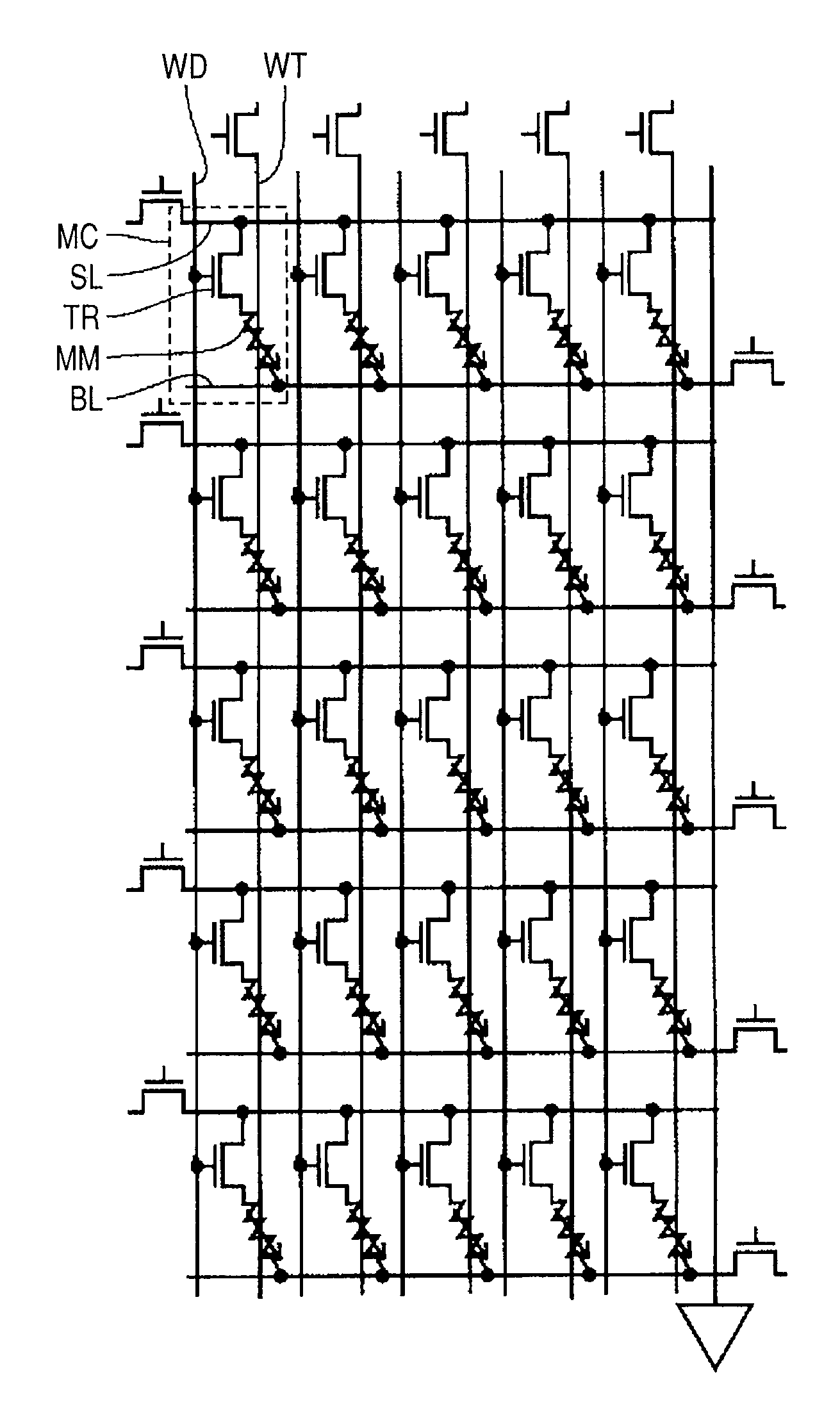Magnetic storage device
- Summary
- Abstract
- Description
- Claims
- Application Information
AI Technical Summary
Benefits of technology
Problems solved by technology
Method used
Image
Examples
first embodiment
Circuitry and Structure of Memory Cells
[0062]First, description will be given to the circuitry of memory cells of a magnetic storage device in the first embodiment of the invention. FIG. 1 is a circuit diagram of memory cells of the magnetic storage device in the first embodiment of the invention.
[0063]In the magnetic storage device, as illustrated in FIG. 1, one memory cell MC (in dotted frame) is comprised of an element selection transistor TR and a magnetic storage element (ferromagnetic tunnel junction element) MM. Multiple memory cells MC are formed in a matrix pattern.
[0064]A write line WT and a bit line BL for rewriting and reading information cross this magnetic storage element MM. A bit line BL is electrically coupled to one end of each of magnetic storage elements MM arranged in juxtaposition in one direction (for example, in rows).
[0065]The write lines WT are so arranged that a magnetic field can be applied to each of magnetic storage elements MM arranged in juxtaposition...
second embodiment
[0155]FIG. 21 is a plan view schematically illustrating the planar shape of a recording layer of a magnetic storage device in a second embodiment of the invention. The cross section structure in this embodiment is the same as in the first embodiment.
[0156]The curved portions 704a and 704b are different from each other in curvature and this recording layer is asymmetric in the direction of hard axis of magnetization. In this recording layer, the substantial easy axis of shape is inclined from the first straight line 63. With respect to the asteroid curve in this case, the magnitude of current as well as the direction of current differs when “1” or “0” is written, as described in relation to plot 36 in FIG. 12. Also in this case, however, the influence of the magnetization of the anchoring layer can be suppressed by providing the recording layer with the laminated structure illustrated in FIG. 4.
[0157]Any difference in the magnitude of current at the time of writing “1” and “0” can be...
third embodiment
[0160]FIG. 22 is a sectional view schematically illustrating the laminated structure of a recording layer of a magnetic storage device in a third embodiment of the invention. The planar shape of this recoding layer is the same as in the first embodiment.
[0161]Description will be given to this embodiment mainly with reference to FIG. 22. The magnetic storage device in this embodiment has a magnetic storage element MMv in place of the magnetic storage element MM (FIG. 4). The magnetic storage element MMv has a recording layer 3v in place of the recording layer 3 in the magnetic storage element MM (FIG. 4).
[0162]The recording layer 3v has such a structure that a ferromagnetic film 3a, a nonmagnetic film 3c (third nonmagnetic film), a ferromagnetic film 3d (fourth ferromagnetic film), and a nonmagnetic metal film 3b are laminated in this order over the tunnel insulating layer 2. The ferromagnetic film 3a is comprised of a cobalt alloy film and is 2 nm in thickness and the nonmagnetic fi...
PUM
 Login to View More
Login to View More Abstract
Description
Claims
Application Information
 Login to View More
Login to View More - R&D
- Intellectual Property
- Life Sciences
- Materials
- Tech Scout
- Unparalleled Data Quality
- Higher Quality Content
- 60% Fewer Hallucinations
Browse by: Latest US Patents, China's latest patents, Technical Efficacy Thesaurus, Application Domain, Technology Topic, Popular Technical Reports.
© 2025 PatSnap. All rights reserved.Legal|Privacy policy|Modern Slavery Act Transparency Statement|Sitemap|About US| Contact US: help@patsnap.com



